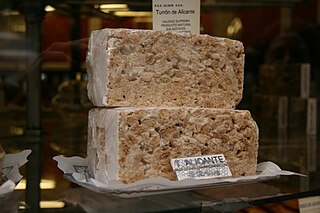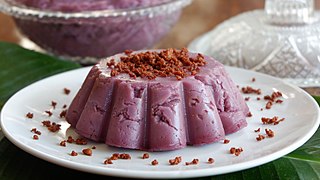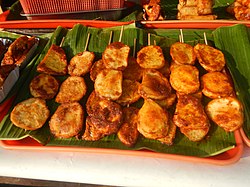
The sweet potato is a dicotyledonous plant that belongs to the bindweed or morning glory family, Convolvulaceae. Its large, starchy, sweet-tasting tuberous roots are used as a root vegetable. The young shoots and leaves are sometimes eaten as greens. Cultivars of the sweet potato have been bred to bear tubers with flesh and skin of various colors. Sweet potato is only distantly related to the common potato, both being in the order Solanales. Although darker sweet potatoes are often referred to as "yams" in parts of North America, the species is even more distant from the true yams, which are monocots in the order Dioscoreales.

Satay, or sate in Indonesian, is a Javanese dish of seasoned, skewered and grilled meat, served with a sauce. The earliest preparations of satay originated in Java, Indonesia. but has spread to almost anywhere in Indonesia, where it has become a national dish. Indonesian satay is often served with peanut sauce and kecap manis – a sweet soy sauce, and is often accompanied with ketupat or lontong, a type of rice cake, though the diversity of the country has produced a wide variety of satay recipes. It is also popular in many other Southeast Asian countries including Brunei, Malaysia, Philippines, Singapore and Thailand. It also recognized and popular in Suriname and the Netherlands. In Sri Lanka, it has become a staple of the local diet as a result of the influences from the local Malay community.

Turrón, torró or torrone is a Mediterranean nougat confection, typically made of honey, sugar, and egg white, with toasted almonds or other nuts, and usually shaped either into a rectangular tablet or a round cake. Turrón is usually eaten as a dessert food around Christmas in Spain and Italy.

Filipino cuisine is composed of the cuisines of more than a hundred distinct ethnolinguistic groups found throughout the Philippine archipelago. A majority of mainstream Filipino dishes that compose Filipino cuisine are from the food traditions of various ethnolinguistic groups and tribes of the archipelago, including the Ilocano, Pangasinan, Kapampangan, Tagalog, Bicolano, Visayan, Chavacano, and Maranao ethnolinguistic groups. The dishes associated with these groups evolved over the centuries from a largely indigenous base shared with maritime Southeast Asia with varied influences from Chinese, Spanish, and American cuisines, in line with the major waves of influence that had enriched the cultures of the archipelago, and adapted using indigenous ingredients to meet local preferences.

Turon (Tagalog pronunciation:[tuˈɾɔn]; also known as lumpiang saging or sagimis in dialectal Tagalog, is a Philippine snack made of thinly sliced bananas, rolled in a spring roll wrapper, fried till the wrapper is crisp and coated with caramelized brown sugar. Turon can also include other fillings. Most common is jackfruit, but there are also recipes with sweet potato , mango , cheddar cheese and coconut .

A fishcake is a culinary dish consisting of filleted fish or other seafood minced or ground, mixed with a starchy ingredient, and fried until golden.

Afghan cuisine is influenced by Persian, Central Asian, and Indian cuisines due to Afghanistan's close proximity and cultural ties. The cuisine is halal and mainly based on mutton, beef, poultry and fish with rice and Afghan bread. Accompanying these are common vegetables and dairy products, such as milk, yogurt, whey, and fresh and dried fruits such as apples, apricots, grapes, bananas, oranges, plums, pomegranates, sweet melons, and raisins. The diet of most Afghans revolves around rice-based dishes, while various forms of naan are consumed with most meals. Tea is generally consumed daily in large quantities, and is a major part of hospitality. The culinary specialties reflect the nation's ethnic and geographic diversity. The national dish of Afghanistan is Kabuli palaw, a rice dish cooked with raisins, carrots, nuts, and lamb or beef.

A banana fritter is a fritter made by deep frying battered banana or plantain in hot cooking oil. It is a common dish across Southeast Asia and South India.

Mexican street food, called antojitos, is prepared by street vendors and at small traditional markets in Mexico. Street foods include tacos, tamales, gorditas, quesadillas, empalmes, tostadas, chalupa, elote, tlayudas, cemita, pambazo, empanada, nachos, chilaquiles, fajitas, tortas, even hamburgers and hot dogs, as well as fresh fruits, vegetables, beverages and soups such as menudo, pozole and pancita. Most are available in the morning and the evening, as mid-afternoon is the time for the main formal meal of the day. Mexico has one of the most extensive street food cultures in Latin America, and Forbes named Mexico City as one of the foremost cities in the world in which to eat on the street.

Inihaw, also known as sinugba or inasal, are various types of grilled or spit-roasted barbecue dishes from the Philippines. They are usually made from pork or chicken and are served on bamboo skewers or in small cubes with a soy sauce and vinegar-based dip. The term can also refer to any meat or seafood dish cooked and served in a similar way. Inihaw are commonly sold as street food and are eaten with white rice or rice cooked in coconut leaves (pusô). Inihaw is also commonly referred to as Filipino barbecue or (informally) Pinoy BBQ.

Banana cue or bananacue is a popular snack food or street food in the Philippines. It is a portmanteau of banana and barbecue, which in Philippine English refers to meat cooked in a style similar to satay.

Ginanggang, guinanggang, or ginang-gang is a snack food of grilled skewered bananas brushed with margarine and sprinkled with sugar. It originates from the island of Mindanao in the Philippines. It literally means "grilled" in Cebuano.

Pinaypay, also known as maruya, is a type of banana fritter from the Philippines. It is usually made from saba bananas. The most common variant is prepared by cutting bananas into thin slices on the sides and forming it into a fan-like shape, and coating it in batter and deep frying them. They are then sprinkled with sugar. Though not traditional, they may also be served with slices of jackfruit preserved in syrup or ice cream. Pinaypay are commonly sold as street food and food sellers at outdoor though they are also popular as home-made merienda snacks among Filipinos.

Ube halaya or halayang ube is a Philippine dessert made from boiled and mashed purple yam. Ube halaya is the main base in ube/purple yam flavored-pastries and ube ice cream. It can also be incorporated in other desserts such as halo-halo. It is also commonly anglicized as ube jam, or called by its original native name, nilupak na ube.
Ancient diet is mainly determined by food's accessibility which involves location, geography and climate while ancient health is affected by food consumption apart from external factors such as diseases and plagues. There are still a lot of doubt about this ancient diet due to lack of evidence. Similar to what anthropologist Amanda Henry has said, there are a lot of time periods in the human history but there are only theories to answer questions on what people actually ate then. Only recently have traces been discovered in what was left of these people.

Lumpia are various types of spring rolls from China, Indonesia, and the Philippines. Lumpias are made of thin paper-like or crepe-like pastry skin called "lumpia wrapper" enveloping savory or sweet fillings. It is often served as an appetizer or snack, and might be served deep-fried or fresh (unfried). Lumpia are Indonesian and Filipino adaptations of the Fujianese rùnbǐng and Teochew popiah, usually consumed during Qingming Festival.

Minatamis na saging is a Filipino dessert made with chopped saba bananas cooked in a sweet syrup (arnibal) made with muscovado sugar and water. Some recipes also add a little bit of salt and pandan leaf or vanilla extract. Other ingredients can also be added like sweet potato, sago, or other fruits like jackfruit. It can be eaten on its own or added as an ingredient to other desserts. Adding the dessert over milk and shaved ice also results in another dessert known as saba con yelo.

Nilupak is a class of traditional Filipino delicacies made from mashed or pounded starchy foods mixed with coconut milk and sugar. They are molded into various shapes and traditionally served on banana leaves with toppings of grated young coconut (buko), various nuts, cheese, butter, or margarine. It is also known as nilusak, linusak, niyubak, linupak, or lubi-lubi, among many other names, in the various languages of the Philippines. It is also known as minukmok in Quezon.



















